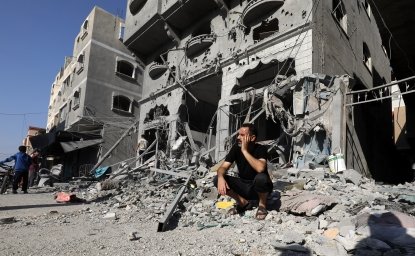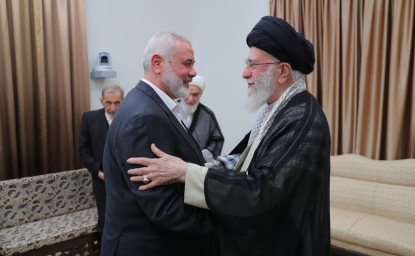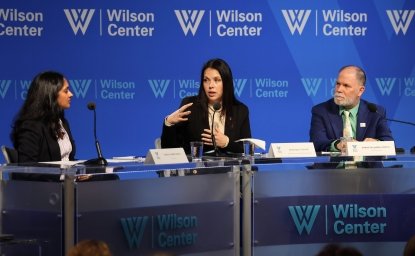Jihadi groups in Syria are still active and pose a threat to the United States, according to new report by the Syria Study Group. Although ISIS lost its territory in Syria and Iraq, thousands of fighters remain at large and the group is turning into a powerful insurgency. “Within Syria, ISIS’s resilient network puts it in a position to take advantage of any pause or reduction in counterterrorism operations,” the group warned. Another group that poses a threat to the United States is Hayat Tahrir al Sham (HTS), an al Qaeda offshoot with an estimated 20,000 fighters that effectively controls Syria’s Idlib province.
The Syria Study Group was established by Congress with the purpose of examining and making recommendations on the military and diplomatic strategy of the United States with respect to the conflict in Syria. The U.S. Institute of Peace was mandated by Congress to facilitate the group. The following is an excerpt from the report.
ISIS and al-Qaeda
The liberation of ISIS-held territory does not eliminate the group’s threat to the United States. Although the United States announced the defeat of ISIS in March 2019, ISIS is reemerging as a powerful insurgency and continues to plan attacks within Syria as well as externally. The group’s leadership is largely intact, maintains “excellent command and control capability” in Syria, and is regrouping across the border in Iraq. Thousands of fighters—estimates range from a few thousand to more than fifteen thousand—remain at large in the country. The group, which at one point was among the richest terrorist organizations in the world, also has substantial financial resources remaining with which to bankroll its operations both locally and internationally.
Within Syria, ISIS’s resilient network puts it in a position to take advantage of any pause or reduction in counterterrorism operations. In December 2018, the commander of U.S. Central Command, General Kenneth F. McKenzie Jr., stated, “I assess that, even after the liberation of ISIS-controlled territory, ISIS probably is still more capable than al-Qaeda in Iraq at its peak, suggesting it is well positioned to reemerge if pressure on the group is relieved.” Already, the group is waging an insurgent campaign of suicide and IED attacks, as well as targeted assassinations, in areas it once controlled.
Abu Bakr al-Baghdadi, the head of ISIS, outlined the group’s strategy in an April 2019 video. He framed a new campaign of attrition against ISIS’s enemies globally. In Iraq and Syria, ISIS is waging a multifront insurgency to degrade anti-ISIS forces and undermine alternative forms of governance. In this new phase, ISIS increasingly seeks both to prevent the formation of alternative forms of governance in northeastern Syria and to exploit Arab Sunni grievances, which are rooted in a growing sense of disempowerment under Kurdish rule. Disaffected Arab communities in ISIS-liberated areas offer a conducive operating environment and an attractive pool of new recruits.
Finally, ISIS ideology remains attractive to groups and individuals far beyond Syria, underscoring the assessment of some U.S. officials that ISIS presents a greater threat to the homeland now than it did when it held territory in Iraq and Syria. On April 21, ISIS took credit for coordinated suicide attacks in Sri Lanka. The group has announced the formation of new “provinces” in, among other places, Afghanistan, Nigeria, and Turkey. Not all of these affiliates present the same level of threat, but taken together they illustrate the continuing appeal of ISIS’s brand.
The ISIS detainee population is a long-term challenge that is not being adequately addressed.
Some ten thousand ISIS fighters are currently being held by the SDF in a handful of temporary detention centers and “pop-up” prisons across northeastern Syria. The vast majority of these detainees—nearly eight thousand, according to U.S. officials—are Iraqis and Syrians.
In addition to the fighters, thousands of ISIS family members, women and children, are held in camps for internally displaced persons (IDPs) across northeastern Syria. U.S. and SDF officials were surprised by the number of people they found in Baghouz, the final area of ISIS-controlled territory. These civilians quickly swelled camp populations, overwhelming capacity. The most overburdened of these camps is located outside the town of al-Hol, near the Iraqi border, and holds roughly seventy thousand individuals, two-thirds of whom are children. The al-Hol camp is at more than twice its capacity, and although the camp managers and NGO partners are providing basic humanitarian relief, there are insufficient resources and capacity to address the health, education, and social services these women and children need. Rehabilitation and reintegration programs for the children of ISIS fighters, many of whom spent formative years living under ISIS’s rule, are nonexistent. The SDF is responding to requests from tribes in eastern Syria for the release of specific detainees; as of April 2019, the SDF had discharged more than one thousand Syrians into tribal custody. The SDF has also transferred hundreds of Iraqis as well as some third-country nationals into Iraqi government custody. Iraq’s courts, however, have significant shortcomings, including low evidentiary standards, allegations of torture to coerce confessions, and hastily conducted trials.
The more than two thousand ISIS foreign fighters currently under SDF custody pose a major challenge. Several countries, including U.S. allies in Europe, either refuse to repatriate their citizens, in some cases stripping them of citizenship, or are willing to repatriate only select family members. Many of these countries lack the necessary evidence to charge ISIS fighters in domestic courts; others worry that the fighters could be convicted only on lesser charges and would serve short sentences before being released.
Offices across the U.S. government address distinct subsets of the ISIS detainee challenge in Syria, but no senior U.S. official holds the mandate to coordinate and implement all U.S. policy on this issue. Coalition military and international humanitarian implementers have equally important but potentially competing priorities, with no honest broker to coordinate them. The U.S. government continues to repatriate American citizens who fought for ISIS and, where possible, facilitates the return of foreign fighters to their country of citizenship. Countries such as Kosovo, North Macedonia, and Italy have undertaken laudable efforts to repatriate ISIS fighters from Syria.
The Global Coalition to Defeat ISIS is working to address the challenges of ISIS detainees and their families, but it is constrained by differences among members regarding repatriation. It did not highlight this issue set in its June 25, 2019, Joint Statement by Political Directors. The SDF has neither the capacity nor the willingness to hold these detainees indefinitely. Security conditions are tenuous inside both IDP camps and pop-up prisons. ISIS exploited multiple prison breaks in Iraq to fuel its rise to power in 2012 and 2013 and is likely contemplating a similar strategy in Syria. Should the Assad regime regain control of northeastern Syria and the detainee population, it could “weaponize” these individuals in the same way it utilized al-Qaeda fighters against the United States during the war in Iraq.
Al-Qaeda and other terrorist groups remain active in Syria and a threat to the United States
Since the start of the Syrian war, al-Qaeda has commanded and supported a variety of groups that share its ideology and commitment to global jihad. Al-Qaeda leader Ayman al-Zawahiri dispatched senior al-Qaeda operatives to Syria who failed to unify these disparate groups. The strongest such groups are Hayat Tahrir al-Sham (HTS), Hurras ad-Din, and Hezb Islami al-Turkistani (TIP). Their forces are concentrated in Idlib, which senior U.S. officials have described as “the largest al-Qaeda safe haven since 9/11.”
HTS is the largest non-ISIS extremist group in Syria, with an estimated twenty thousand fighters, according to the United Nations. It has effective, although not complete, control over Idlib and formed a “Salvation Government,” which is slowly exerting control over all governance structures. Hurras ad-Din formed in February 2018 as a splinter from HTS and has an estimated seven hundred fighters with the capacity and the desire to conduct external attacks. Hurras ad-Din and HTS have had serious leadership disputes over strategy in Syria and occasionally compete locally, but they continue to cooperate despite this friction. Compared with HTS, Hurras ad-Din has a larger proportion of foreign fighters and focuses more on external attacks than on operations inside Syria.
On June 30, 2019, U.S. Central Command carried out an airstrike against al-Qaeda operatives “responsible for plotting external attacks” in western Aleppo. The U.S. attack was notable given Russian control of the airspace in northwestern Syria.
Click here for the full report.

The Islamists
Learn more about Hamas and how it relates to similarly aligned organizations throughout the region. Read more

Explore More
Browse Insights & Analysis
Israel Escalates Attacks in Gaza: What’s Next?

Israel Expands Operations on Multiple Fronts: Perspectives on the Conflict

